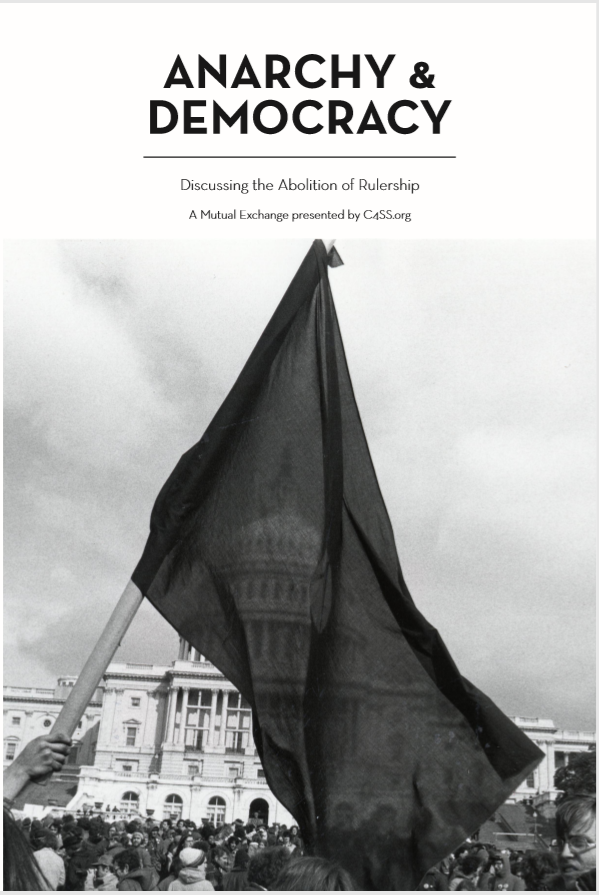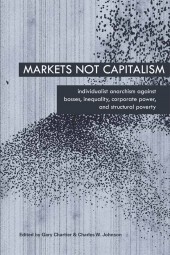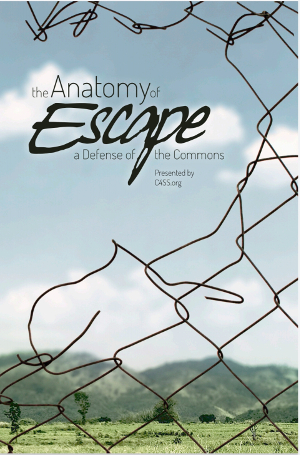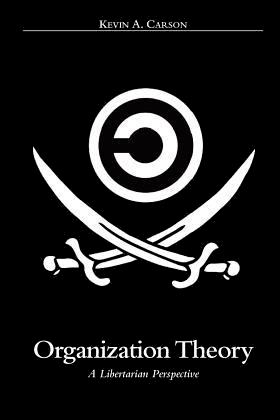What is C4SS?
Politically, C4SS was founded to help promote the diverse perspectives found in left market anarchist circles. Our target audiences have long run the gamut from complete mainstream normies, to anarchist insurrectionaries, to libertarian academics. We are anarchists because we oppose every form of domination, but we are also rooted in one of the oldest traditions of anarchism in that we believe markets can be valuable for free people, albeit in a more egalitarian form without bosses, poverty, or severe wealth disparity.
Socially, C4SS emerged as a refuge for market anarchists (of many flavors) critical of capitalism who also rejected nationalism, intellectual property, and other creeping reactionary tendencies in corners of the old Alliance of the Libertarian Left. Our staff is split in original backgrounds between the traditional anarchist movement and the libertarian movement.
Operationally, C4SS primarily comprises 1) a listserv of seventy or so loosely associated people that offer feedback on essay submissions and occasionally exercises a loose consensus process on formal group decisions, and 2) some distinct text chats for everyone listed as a coordinator to handle more nuts-and-bolts things and occasionally bring proposals to the list. Formal membership is limited to fellows, chairs, and coordinators (who have small domains of responsibility), but the consensus process can draw in the voices of more loosely connected people, and day-to-day operations are handled more or less autonomously by the coordinators. A small team of editors coordinates editing submissions from both members and the public at large.
Financially, C4SS is pretty much a volunteer project that gets on average a few hundred dollars every month between small individual donations, Patreon contributions, and donations from the C4SS Store (run by James Tuttle). We hold nonprofit status via the graciousness of Roderick Long’s Molinari Institute (this basically just means he volunteers to file our tax paperwork every year). We focus on paying contributing writers and translators, with some technical costs and occasional projects. We offer regulars a percentage of our monthly donations and contractors, first-time writers, or those contributing in response to “bounties” a fixed amount.
History
Left market anarchism is a contemporary umbrella term that maps commonalities and inclinations dating back to the beginning of the anarchist movement. From Proudhon to the influential three-decade run of the journal Liberty, early mutualist perspectives came to find root among American abolitionists like William Batchelder Greene, Josiah Warren, and Lysander Spooner, and came to more full-throated expression with Benjamin Tucker and Voltairine de Cleyre. Market anarchists played roles across the anarchist movement, from labor organizer Dyer D Lum smuggling Louis Lingg dynamite in prison to Jo Labadie organizing the salvage and preservation of anarchist documents.
In the wake of the second world war, a distinct libertarian tradition emerged in America in the vein of state-critical classical liberals like Frederic Bastiat and Gustave de Molinari. This libertarian movement often identified with anarchism – albeit with weak continuity to the anarchist movement proper – and just as often moved in sharply right-wing directions. However, figures like Karl Hess and Robert Anton Wilson attempted to bridge the gap, taking inspiration and critical analyses from both traditions, and trying to bend the emerging libertarian movement back to the radical left.
Meanwhile, the mainline anarchist movement had not died and neither had its market anarchist current, with projects like Red Lion Press and the Boston Anarchist Drinking Brigade continuing to publish.
In the 90s, with the emergence of the internet, anarchists and libertarians started coming into regular contact and conflict online. In this fighting there were a number of folks that attempted to resolve the contradictions in a productive synthesis, as well as those worried that the polarized conflict threatened to erase the market anarchism of many early mutualists. Individual writers and historians worked in different directions on a number of projects, notably Kevin Carson and Roderick Long, but in general folks were only loosely tied through a number of listservs like Sam Konkin’s Movement of the Libertarian Left and later the Alliance of the Libertarian Left (formed in response to Neil Schulman’s “informational property” claims and litigation threats). These coalitions were more debate salons than organizations, and they dissolved in various conflicts with new forks forming to exclude different reactionaries.
In rough terms, this more fractious era ended with a consistent set of folks stabilizing around C4SS in our rejection of 1) social reactionaries, 2) intellectual property apologists, 3) nationalists, and 4) non-anarchists more generally.
In its humble roots, C4SS was intended as a media project to inject editorials on various current events into local newspapers around the world. But relatively quickly it became an institution with a broader purpose. Ad hoc translations of current events editorials turned into broader efforts to translate theory into a wide array of languages. Small hosted debates became our flagship Mutual Exchange symposiums, which in turn became books. We started publishing in-depth reviews of books and long academic studies on various topics. Our internal discussion listserv grew to many dozens of people, and our contributing writers would grow to the hundreds.
Gary Chartier and Charles Johnson published Markets Not Capitalism with Autonomedia and AK Press, an attempt to compile the wide array of writings in the wider “left market anarchist” milieu. It was compiled in a period when C4SS still was a relatively minor project and hadn’t really grown into its own. Charles ran the Distro of the Libertarian Left, which in turn had built on top of Invisible Molotov, as well as pulling from the journal ALLiance. Increasingly, however, people assumed that these projects were all synonymous and would contact C4SS as if we controlled them. This had the effect – along with changes in internet media consumption patterns – of centralizing activity into C4SS.
Ideology
It’s easier to understand C4SS as a magazine that hosts debate rather than as some vanguard cadre or political party issuing collective proclamations. While we do have shared values, broadly classified as “left market anarchism,” we are a motley crew.
The strongest historical parallel to C4SS is the journal Liberty, the influential mutualist paper run out of Boston by Benjamin Tucker, and populated by an unruly assortment of anarchists like Voltairine de Cleyre, Dyer D Lum, Lysander Spooner, et al. But there are, of course, differences. Unlike Liberty, we are not, at the end of the day, the editorial or political vision of a single person like Tucker. We encourage dissent and diversity of opinions, although we maintain some sharp ethical boundaries.
Most of us have at least some disagreements with most things we publish. And we have published submissions from people from across almost every spectrum, from communists to capitalists, nihilists to christians, insurrectionaries to gradualists, utilitarians to deontologists, primitivists to transhumanists. We are, however, at the end of the day, an anarchist project, expecting an underlying opposition to all forms of domination to shine through every perspective we publish. And thus there are a number of both explicit and tacit litmus tests we apply; most notably, we stridently reject intellectual property and nationalism, but we also reject racism, sexism, homophobia, transphobia, ableism, ageism, et al.
We are primarily a platform for critiques of the state and discussions over the ideal shape of a stateless society, so while we encourage wide-ranging debate, that does not extend to platforming authoritarians and statists.
Internally, we are split over a number of different issues, such as philosophy of ethics (our ranks include virtue ethicists, consequentialists, deontologists, and egoists) as well as tactics and language. In ideological terms, some members identify as “mutualists,” some as merely “individualist anarchists,” some as “left rothbardians,” some as “syndicalists,” some as “egoists,” a few even as “radical liberals,” the list goes on, with many more unique individual positions.
While we all critique capitalism and defend markets, the exact critiques and defenses can somewhat differ from person to person. However, there are some baseline commonalities: we critique the hierarchies of private tyranny within workplaces, we critique monopolies and runaway concentrations of wealth, and we critique systemic class disparities. But we also embrace title and networks of exchange. For a selection of some takes, see our Mutual Exchanges on property, on capitalism, and on decentralized economic coordination.
With submissions from hundreds of people spanning well over a decade, there are inevitably examples of ideological drift from contributors. We generally don’t remove previously published content except in some cases of severe abuse or reactionary entryism. This means that a few contributors have since dropped identification with anarchism or otherwise altered their perspective. In the cases where the author explicitly wants and demands from us, we replace names with pseudonyms. It would be impossible to keep track of the ideological or personal trajectories of every person who has ever contributed to us, but we do appreciate heads-up in bad cases.
Nasty Roadbumps
Probably the best thing that happened to C4SS and allowed it to flourish was the early removal of one Brad Spangler. Brad had been among the core founders but had pretty much abandoned the project by the time he got involved in Occupy, ignoring emails and pilfering funds. He was kicked out by the rest of the group and the fancy role he had granted himself of “Director” was given to James Tuttle, who had been editor of ALLiance. James helped right the boat after Brad’s malign mismanagement and expanded and deepened the Center’s project.
Unfortunately the bad news continued from Brad. He took to transphobic comments on Facebook and hit on women inappropriately, causing most of us active on Facebook to denounce and defriend him. Then, years later, having for a long while heard nothing from him, in 2015 we abruptly learned that Brad had molested a child. Within a day, we’d published a public denouncement and removed his lingering old content from the site. Additionally, I wrote a second sharper personal piece criticizing the libertarian movement and our own circles for both failing to recognize the deeper rot in him, and not having more strenuously run him out of wider social circles for what creepy and transphobic behavior we did see.
Every organization of any size eventually has to deal with monsters, and unfortunately many cover them up or publicly go to bat for them. Thankfully, the internal culture we’ve forged has been following the wishes of survivors and proactively disassociating from abusers. A brief list of the darker moments we had to weather: Stacy Litz, who had risen to lead the coordination of our student groups turned state’s evidence against her friends on drug charges. Doreen de Cleyre had served as an editor with us but was exposed as a rapist. Chris Shaw likewise started to work as an editor but was caught also writing directly for a “national anarchist” (cryptofascist) website.
There are – just by population statistics – possibly still more scumbags lurking undiscovered in an organization so large and with so many folks moving through involvement. What we try to do is create a reputation for respectfully following the requests of survivors so we can get reports of misbehavior early and to create a culture internally where no tolerance is ever expected for such infractions.
Because we sit at the intersection of a variety of ideological discourses, fascists have long identified us as either particularly abhorrent corruptors or as an opportunity to push and legitimize cryptofascist discourse. Figures like Hans Herman Hoppe and Christopher Cantwell have identified us at points as their number one enemy. Some of the earliest content of The Right Stuff singled us out for hate. Additionally, we’ve faced nearly annual attempts by folks associated with the “pan-secessionist” / “national anarchist” circle to try to infiltrate us or convert people loosely associated with us.
The most noteworthy moment was when the disgusting racist Oliver Janssens attempted to steal control over the Facebook of a student group associated with us in Belgium. When we published a disassociation that included screenshots of his own racist posts, he used his wealth to get a lawyer to issue a DMCA take-down of our webserver because, in the lawyer’s actual words, we had “decided to embarrass Oliver Janssens in the worst and most effective way – by words out of his own mouth.” The incident got international attention and he backtracked, but well after we’d exposed his bullshit, even contacting his teachers. He donated money to us, which we then donated to Belgian anti-racists and antifascists, as well as a number of anarchist projects in the global south.
In a kind of inverse situation, our opposition to intellectual property has also led to situations where reactionary outlets have republished our content, often hoping to muddy the waters or help provide scaffolding for third-positionist projects. Everything we publish is public domain / anti-copyright, we refuse to use the state against even fascists, but our hostility towards such misuses is obvious.
Operating Structure
An organization’s formal structure can serve to cloak the implicit informal relationships and activities that underpin it, just as such formalism can get in the way of more human relationships and fluid responses. While C4SS has a broad Working Group, plus the coordinators and the editors, there are obviously numerous side-chats and person-to-person conversations that help coordinate the project. We’re also spread out across communication platforms, with different people more or less easily reachable in different spaces, Discord, Signal, Twitter, Facebook, etc.
Each coordinator handles a distinct domain related to their interest. This enables some level of accountability but it primarily gives individuals a sense of investment. So, for example, Cory Massimino handles social media posts while I keep the website and technical infrastructure afloat. We’ve made recurring pushes to try to spread out access to such domains, to avoid any one person becoming a failure point, but in practice there tends to only be one person with sufficient personal interest and investment to keep bottom-lining a given task.
The second issue that creates unfortunate concentrations in practice is trust. As a highly distributed international project, we often have never even met in person the people most interested in contributing to us. Even video meetings are incredibly hard to organize because of different time zones. Beyond learning someone’s temperament or organizing style, there’s the issue of attention and commitment. A project that is maintained for over a decade has a slower pace and thinks in terms of years. Often, someone will reach out to us very interested in helping with a specific task, but their interest is fickle and they get distracted by something else or have personal issues intervene after only a few months. On-boarding is expensive, attention and capacity are limited, so we tend to let people voluntarily contribute and see whether they last. This also gives us the opportunity to build up experience with them personally. We tend to think in terms of years, not months.
One of the more interesting dynamics in recent years has been individuals who, upon getting some submissions accepted for publication or becoming involved in some work or discussions, start presenting themselves as “members of C4SS,” and unilaterally speaking on behalf of us. This is frustrating and has made for hard conversations, but also speaks to our limited capacity to explain everything to everyone or catch up and acculturate folks quickly. (This article is an attempt to create more clarity, in part so we don’t have to repeat everything for every single person writing for us.) Getting involved with a project requires a certain level of humility and attention, it takes time to know individuals, currents, tensions, norms, and culture. While we would like to have more bandwidth, C4SS is a project of love that we work on in spare minutes between work, life, and other academic and activist projects. Navigating those scarcities is a fraught task that makes C4SS fall short of some of our ideals.
On the one hand, it’s important to respect the level of investment and tacit knowledge of those already involved, as well as the traditions or norms built up from experiment and praxis, while navigating inherent issues of trust. On the other hand, it’s important to avoid ossified hierarchies, cliques, or patronage networks. This takes active work and concessions from everyone involved; it ultimately cannot be solved through structure but through intent and culture. A coordinator must be proactively charitable towards tendencies or individuals they do not agree with or like, the group must studiously heed dissent and blocks to consensus, proposals should be work-shopped with preemptive attentiveness to every likely perspective, and concerning behavior should be investigated compassionately and forthrightly. These are not tendencies that can be ordained, they must be attentively built.
What has helped C4SS survive and flourish over the years despite occasional road-bumps has been the ethical sincerity and nerdiness of many attracted to us. It helps that the stakes are so low to those not invested in our values. We are not a titanic institution that promises a path to power or respect in some scene, academic or activist, rather we function as something of a remote monastery or maroon. A refuge for escapees from unproductive ideological wars and team conflicts. Iconoclasts who are not merely trying to climb a different status hierarchy (of edge-lordism), but who are so sincere that they willingly embrace unpopular directions.
While gradients of trust, scarcities of personal attention, and the inherent inside-outside hierarchies remain issues to be navigated, we’ve cultivated an egalitarian culture of peers where one person can wear one hat one day and a different hat the next, or drift out of activity and then return. Whatever proclamations are decided at the abstract collective level of consensus process, the project itself is affirmed and navigated from the bottom-up level of individual relationships.
While there can be some centralization, where for example the past, present, and future “coordinating directors” of James, me, and Alex (and whoever else shows up) have the attention and energy to talk for hours on a call about various plumbing issues, the informal and fluid nature of the project itself provides checks on us. We are constantly trying to preemptively avoid stepping on anyone’s toes, lest we create a combative or conflictual internal dynamic that would undermine the entire project and cause writers and friends to evaporate away. It is only through such efforts that we can build and retain safe spaces for sharp debate and disagreement.
This is not to suggest that everything is rosy or that our organizational form is some kind of blueprint. It is rather an intensely problematic concession that has emerged in hands-on grappling with a number of constraints.
And who knows, C4SS in a year or two might be a radically different sort of organization. We might become a publishing house or archive project. We may cease operations! After all, it is one of the most core anarchist responsibilities to know when a project has served its use and not to fetishize or try to extend it as an end in itself.









